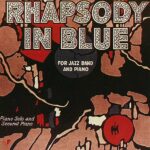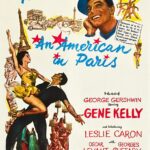Rhapsody in Blue is a 1924 musical composition written by George Gershwin for solo piano and jazz band, which combines elements of classical music with jazz-influenced effects. Commissioned by bandleader Paul Whiteman, the work premiered in a concert titled “An Experiment in Modern Music” on February 12, 1924, in Aeolian Hall, New York City. Whiteman’s band performed the rhapsody with Gershwin playing the piano. Whiteman’s arranger Ferde Grofé orchestrated the rhapsody several times including the 1924 original scoring, the 1926 pit orchestra scoring, and the 1942 symphonic scoring.
The rhapsody is one of Gershwin’s most recognizable creations and a key composition that defined the Jazz Age. Gershwin’s piece inaugurated a new era in America’s musical history, established his reputation as an eminent composer and became one of the most popular of all concert works. In the American Heritage magazine, Frederic D. Schwarz posits that the famous opening clarinet glissando has become as instantly recognizable to concert audiences as the opening of Beethoven’s Fifth Symphony.
Following the success of an experimental classical-jazz concert held with Canadian singer Éva Gauthier in New York City on November 1, 1923, bandleader Paul Whiteman decided to attempt a more ambitious feat. He asked composer George Gershwin to write a concerto-like piece for an all-jazz concert in honor of Lincoln’s Birthday to be given at Aeolian Hall. Whiteman became fixated upon performing such an extended composition by Gershwin after he collaborated with him in The Scandals of 1922. He had been especially impressed by Gershwin’s one-act “jazz opera” Blue Monday. Gershwin initially declined Whiteman’s request on the grounds that he would have insufficient time to compose the work and there would likely be a need to revise the score.
Soon after, on the evening of January 3, George Gershwin and lyricist Buddy DeSylva played a game of billiards at the Ambassador Billiard Parlor at Broadway and 52nd Street in Manhattan. George’s brother, Ira Gershwin, interrupted their billiard game to read aloud the January 4 edition of the New-York Tribune. An unsigned Tribune article entitled “What Is American Music?” about an upcoming Whiteman concert had caught Ira’s attention. The article falsely declared that George Gershwin had begun “work on a jazz concerto” for Whiteman’s concert.
The news announcement puzzled Gershwin as he had politely declined to compose any such work for Whiteman. In a telephone conversation with Whiteman the next morning, Whiteman informed Gershwin that Whiteman’s arch rival Vincent Lopez planned to steal the idea of his experimental concert and there was no time to lose. Whiteman thus finally persuaded Gershwin to compose the piece.



 Saskatoon, Saskatchewan native Kelsey Ronn, is praised for being “fully formed musically and dramatically” (Opera Canada) and performs actively as a soloist, competitor and operatic vocalist throughout Canada and the United States. She is known for her euphonious tone, florid coloratura, and warm timbre.
Saskatoon, Saskatchewan native Kelsey Ronn, is praised for being “fully formed musically and dramatically” (Opera Canada) and performs actively as a soloist, competitor and operatic vocalist throughout Canada and the United States. She is known for her euphonious tone, florid coloratura, and warm timbre. An adamant believer in the power of music to unite, inspire, and elevate, Shokhrukh (Shah) Sadikov is one of the most driven young conductors of his generation. From concert halls to classrooms, community centres and libraries, Sadikov leads an engaged career as a conductor, violist, and music educator. His work with numerous organizations, hundreds of people, and advocacy of access to the arts-for-all stands as a testimony to his belief.
An adamant believer in the power of music to unite, inspire, and elevate, Shokhrukh (Shah) Sadikov is one of the most driven young conductors of his generation. From concert halls to classrooms, community centres and libraries, Sadikov leads an engaged career as a conductor, violist, and music educator. His work with numerous organizations, hundreds of people, and advocacy of access to the arts-for-all stands as a testimony to his belief. Adam hails from Burlington, Ontario and has been performing live across North America for the last 25 years.
Adam hails from Burlington, Ontario and has been performing live across North America for the last 25 years. Conductor, arranger, bassist and educator Mitchell Tyler is an Honours Bachelor of Music (Theory & Composition) and Bachelor of Education graduate of Western University, and has been a member of the Jeans ‘n Classics Band since 1992.
Conductor, arranger, bassist and educator Mitchell Tyler is an Honours Bachelor of Music (Theory & Composition) and Bachelor of Education graduate of Western University, and has been a member of the Jeans ‘n Classics Band since 1992.